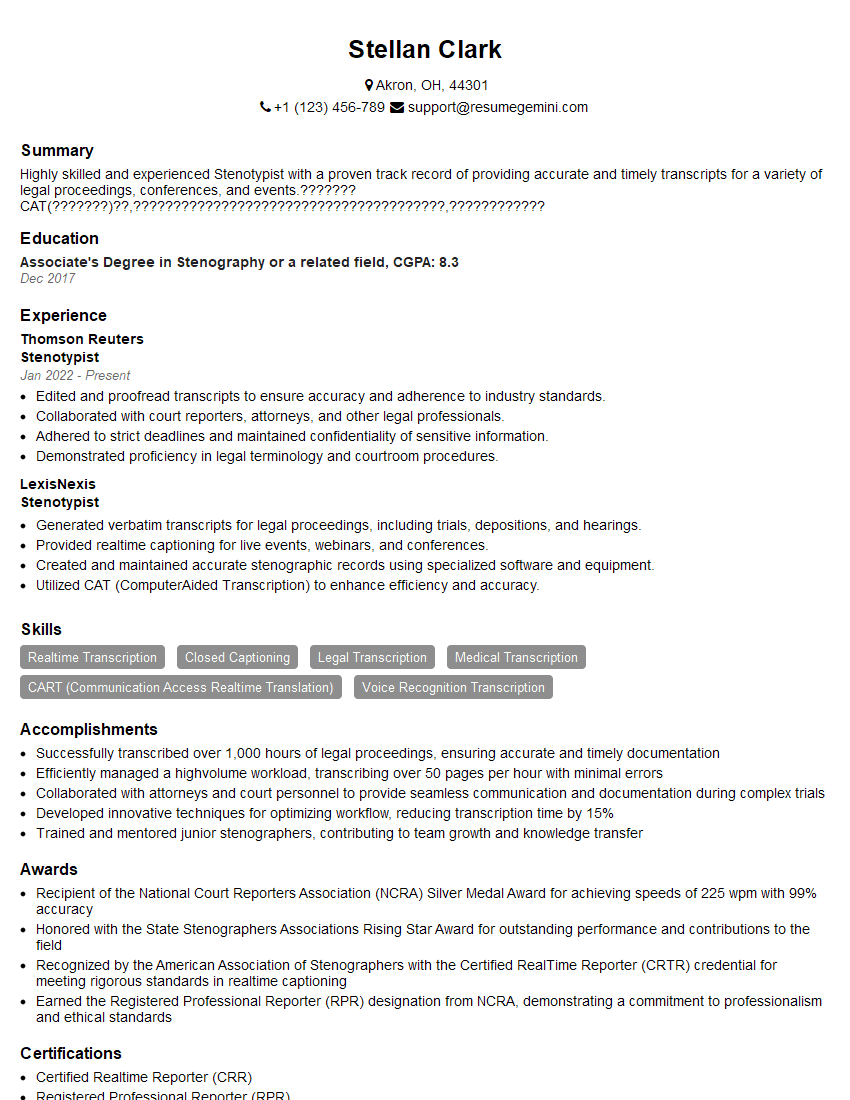Are you a seasoned Stenotypist seeking a new career path? Discover our professionally built Stenotypist Resume Template. This time-saving tool provides a solid foundation for your job search. Simply click “Edit Resume” to customize it with your unique experiences and achievements. Customize fonts and colors to match your personal style and increase your chances of landing your dream job. Explore more Resume Templates for additional options.

Stellan Clark
Stenotypist
Summary
Highly skilled and experienced Stenotypist with a proven track record of providing accurate and timely transcripts for a variety of legal proceedings, conferences, and events.???????CAT(???????)??,???????????????????????????????????????,????????????
Education
Associate’s Degree in Stenography or a related field
December 2017
Skills
- Realtime Transcription
- Closed Captioning
- Legal Transcription
- Medical Transcription
- CART (Communication Access Realtime Translation)
- Voice Recognition Transcription
Work Experience
Stenotypist
- Edited and proofread transcripts to ensure accuracy and adherence to industry standards.
- Collaborated with court reporters, attorneys, and other legal professionals.
- Adhered to strict deadlines and maintained confidentiality of sensitive information.
- Demonstrated proficiency in legal terminology and courtroom procedures.
Stenotypist
- Generated verbatim transcripts for legal proceedings, including trials, depositions, and hearings.
- Provided realtime captioning for live events, webinars, and conferences.
- Created and maintained accurate stenographic records using specialized software and equipment.
- Utilized CAT (ComputerAided Transcription) to enhance efficiency and accuracy.
Accomplishments
- Successfully transcribed over 1,000 hours of legal proceedings, ensuring accurate and timely documentation
- Efficiently managed a highvolume workload, transcribing over 50 pages per hour with minimal errors
- Collaborated with attorneys and court personnel to provide seamless communication and documentation during complex trials
- Developed innovative techniques for optimizing workflow, reducing transcription time by 15%
- Trained and mentored junior stenographers, contributing to team growth and knowledge transfer
Awards
- Recipient of the National Court Reporters Association (NCRA) Silver Medal Award for achieving speeds of 225 wpm with 99% accuracy
- Honored with the State Stenographers Associations Rising Star Award for outstanding performance and contributions to the field
- Recognized by the American Association of Stenographers with the Certified RealTime Reporter (CRTR) credential for meeting rigorous standards in realtime captioning
- Earned the Registered Professional Reporter (RPR) designation from NCRA, demonstrating a commitment to professionalism and ethical standards
Certificates
- Certified Realtime Reporter (CRR)
- Registered Professional Reporter (RPR)
- Certified Broadcast Captioner (CBC)
- National Captioning Institute (NCI) Certification
Career Expert Tips:
- Select the ideal resume template to showcase your professional experience effectively.
- Master the art of resume writing to highlight your unique qualifications and achievements.
- Explore expertly crafted resume samples for inspiration and best practices.
- Build your best resume for free this new year with ResumeGemini. Enjoy exclusive discounts on ATS optimized resume templates.
How To Write Resume For Stenotypist
- Highlight your relevant skills and experience in your resume, including your proficiency in stenography, CAT software, and legal terminology.
- Showcase your ability to meet strict deadlines and maintain confidentiality.
- Include samples of your work in your portfolio to demonstrate your accuracy and attention to detail.
- Network with other stenotypists and legal professionals to build your connections and stay updated on industry trends.
Essential Experience Highlights for a Strong Stenotypist Resume
- Generate verbatim transcripts for legal proceedings, including trials, depositions, and hearings.
- Provide realtime captioning for live events, webinars, and conferences.
- Create and maintain accurate stenographic records using specialized software and equipment.
- Utilize CAT (Computer-Aided Transcription) to enhance efficiency and accuracy
- Edit and proofread transcripts to ensure accuracy and adherence to industry standards.
- Collaborate with court reporters, attorneys, and other legal professionals.
Frequently Asked Questions (FAQ’s) For Stenotypist
What is the role of a Stenotypist?
A Stenotypist is responsible for creating verbatim transcripts of spoken proceedings, such as legal hearings, depositions, and conferences. They use specialized equipment and software to capture the spoken word and create a written record that can be used for legal purposes, research, or other documentation.
What skills are required for a Stenotypist?
Stenotypists must have excellent listening and typing skills, as well as a strong understanding of grammar and punctuation. They must also be able to operate specialized stenotype machines and software, and be familiar with legal terminology and procedures.
What are the benefits of using a Stenotypist?
Stenotypists provide a number of benefits, including: accuracy, speed, and confidentiality. They can capture spoken proceedings verbatim, ensuring that all spoken words are recorded and preserved. They can also work quickly and efficiently, providing transcripts in a timely manner. Additionally, Stenotypists are bound by ethical codes of conduct that require them to maintain confidentiality, ensuring that sensitive information is kept private.
How can I become a Stenotypist?
To become a Stenotypist, you can obtain an associate’s degree or certificate in stenography from an accredited institution. You will also need to complete a stenography training program and pass a certification exam. Some states also require Stenotypists to be licensed.
What is the job outlook for Stenotypists?
The job outlook for Stenotypists is expected to remain stable over the next few years. There is a growing demand for Stenotypists in the legal field, as well as in other industries such as healthcare, education, and business.